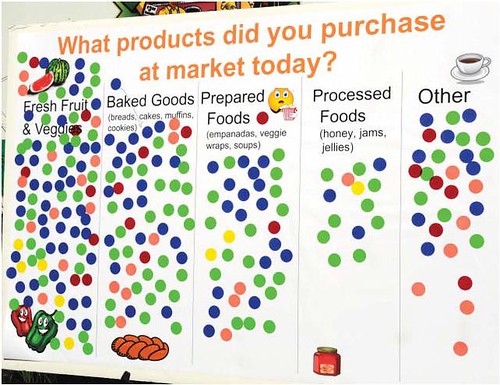
In business, location means everything. Not only do businesses need to understand where their customer base exists, but they also need to know where their competitors are. The same applies to farmers markets: they must understand their customers and competition to determine the potential for profit. The location of a farmers market can influence a vendor or customer’s decision to support a particular market.
At USDA’s Agricultural Marketing Service (AMS), the Farmers Market and Direct Marketing Research Branch has been researching the business of farmers markets for nearly two decades, striving to provide farmers and consumers with information and tools to make strategic business and purchasing decisions. Regarding the location and frequency of farmers markets, we have worked closely with our colleagues at USDA’s Economic Research Service (ERS) to recently publish a report entitled Mapping Competition Zones for Vendors and Customers in US Farmers Markets, which draws on data gathered from the 2006 National Farmers Market Manager Survey and the USDA Farmers Market Directory.
Through the collaboration, we generated maps that show the density, and in some cases scarcity, of farmers market locations. We were also able to determine, on average, how far producers and customers travel to participate in farmers markets. With this information, farmers market managers can develop stronger business plans, recruit appropriate vendors, create targeted customer marketing initiatives, and develop partnerships with nearby markets to create better market draw and stronger market success. This is especially true of major urban areas, like New York, Boston, Washington, DC, Los Angeles and other cities with relatively high farmers market density.
Take Washington, DC, for example. AMS manages USDA’s weekly farmers market. Since this location is considered a high density area, we thought it would be a good idea to learn more about our farmers market’s appeal and operations from the customer point of view. To help place our market in perspective, USDA’s weekly outdoor farmers market (which operates from June to November) takes place in a parking lot steps away from the National Mall in downtown DC, and can attract over 2,000 shoppers on a good market day.
Over two days last summer, we used an informal dot survey to ask customers what they purchased at the market, what they spent at the market, how many vendors they bought products from, and why they were motivated to shop at the market. We also inquired about how often they patronized the market, if shopping at the farmers market influenced their produce consumption in any way, and what we could do to improve the market’s atmosphere and operations.

The results were fascinating. We learned that while more than two-thirds of market shoppers were either from USDA or employees of other government agencies who worked in the area, more than 15 percent of our surveyed shoppers were tourists! We learned that freshness, supporting local agriculture, and convenience were among the top reasons for shopping at the market. We became aware that the farmers market helped nearly 60% of our shoppers eat more fruits and vegetables. We also learned that nearly 30% of our customers were first-time shoppers, indicating some more sophisticated marketing efforts might be in order.
Results showed that customers wanted us to increase the amount of fresh fruit and vegetable vendors at market, as well as expand the availability of prepared foods. Customers also expressed an eagerness for us to keep the market going all year-round. Through the feedback that we gathered, we were able to implement many of these suggestions, including the implementation of a full, year-round market season for the first time ever, and the extension of market hours has been welcomed with open arms.
We believe that access to and utilization of good information can help a business, including farmers markets, make advantageous decisions. To access more information that could be beneficial to the growth or development of your farmers market, please visit our program homepage. The USDA National Farmers Market Directory is also a good tool for finding farmers markets in a specific community. And don’t be afraid to gather additional data of your own regarding your specific market environment using our dot survey and other research tools as guidelines. The secret of a successful market is both knowing your customer base...and knowing your market potential.
